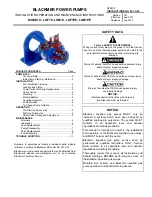
Installation
Check
Explanation/comment
Checked
Suggested suction strainers are
Suction strainers help to prevent
used. Check that they are at least debris from entering the pump.
three times the area of the suction Liquids with specific gravity less
piping.
than 0.60 a pressure drop across
Monitor the pressure drop across
the suction strainer may be due to
the suction strainer.
ice buildup. Ice buildup can cause
turbulence, low pressure areas
An increased pressure drop
and pumpage vaporization.
across the strainer of 5 psi (34.5
kPa) indicates that the strainer
should be removed and cleaned.
After a period of time (24 hours
minimum) system flushing should
be complete and the suction
strainer can be removed.
If more than one pump operates
This recommendation helps you
from the same liquid source,
to achieve a higher pump perfor-
check that separate suction-piping mance and prevent vapor locking
lines are used for each pump.
especially with specific gravity of
liquid less than 0.60.
If necessary, make sure that the
—
suction piping includes a drain
valve and that it is correctly in-
stalled.
Assure adequate insulation is ap- To assure sufficient NPSHa.
plied for liquids with specific grav-
ity less than 0.60.
Liquid source below the pump
Check
Explanation/comment
Checked
Make sure that the suction piping
This helps to prevent the occur-
is free from air pockets.
rence of air and cavitation in the
pump inlet.
Check that the suction piping
—
slopes upwards from the liquid
source to the pump inlet.
If the pump is not self-priming,
Use a foot valve with a diameter
check that a device for priming the that is at least equivalent to the
pump is installed.
diameter of the suction piping.
Liquid source above the pump
Check
Explanation/comment
Checked
Check that an isolation valve is
This permits you to close the line
installed in the suction piping at a
during pump inspection and main-
distance of at least two times the
tenance.
pipe diameter from the suction
Do not use the isolation valve to
inlet.
throttle the pump. Throttling can
cause these problems:
• Loss of priming
• Excessive temperatures
• Damage to the pump
• Voiding the warranty
Make sure that the suction piping
This helps to prevent the occur-
is free from air pockets.
rence of air and cavitation in the
pump inlet.
Check that the piping is level or
—
slopes downward from the liquid
source.
Make sure that no part of the
—
suction piping extends below the
suction flange of the pump.
Make sure that the suction piping
This prevents air from entering the
is adequately submerged below
pump through a suction vortex.
the surface of the liquid source.
32
Model 3610, API Type BB1 API 610 11th Edition Installation, Operation, and Maintenance Manual
















































